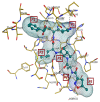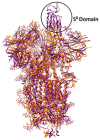A Comprehensive Review about the Molecular Structure of Severe Acute Respiratory Syndrome Coronavirus 2 (SARS-CoV-2): Insights into Natural Products against COVID-19
- PMID: 34834174
- PMCID: PMC8624722
- DOI: 10.3390/pharmaceutics13111759
A Comprehensive Review about the Molecular Structure of Severe Acute Respiratory Syndrome Coronavirus 2 (SARS-CoV-2): Insights into Natural Products against COVID-19
Abstract
In 2019, the world suffered from the emergence of COVID-19 infection, one of the most difficult pandemics in recent history. Millions of confirmed deaths from this pandemic have been reported worldwide. This disaster was caused by SARS-CoV-2, which is the last discovered member of the family of Coronaviridae. Various studies have shown that natural compounds have effective antiviral properties against coronaviruses by inhibiting multiple viral targets, including spike proteins and viral enzymes. This review presents the classification and a detailed explanation of the SARS-CoV-2 molecular characteristics and structure-function relationships. We present all currently available crystal structures of different SARS-CoV-2 proteins and emphasized on the crystal structure of different virus proteins and the binding modes of their ligands. This review also discusses the various therapeutic approaches for COVID-19 treatment and available vaccinations. In addition, we highlight and compare the existing data about natural compounds extracted from algae, fungi, plants, and scorpion venom that were used as antiviral agents against SARS-CoV-2 infection. Moreover, we discuss the repurposing of select approved therapeutic agents that have been used in the treatment of other viruses.
Keywords: COVID-19; SARS-CoV-2; antioxidants; antivirals; coronavirus; molecular structure; natural products; therapeutic approach; vaccines; virus detection; virus lifecycle.
Conflict of interest statement
The authors declare no conflict of interest.
Figures








Similar articles
-
Current status of antivirals and druggable targets of SARS CoV-2 and other human pathogenic coronaviruses.Drug Resist Updat. 2020 Dec;53:100721. doi: 10.1016/j.drup.2020.100721. Epub 2020 Aug 26. Drug Resist Updat. 2020. PMID: 33132205 Free PMC article. Review.
-
Current Strategies of Antiviral Drug Discovery for COVID-19.Front Mol Biosci. 2021 May 13;8:671263. doi: 10.3389/fmolb.2021.671263. eCollection 2021. Front Mol Biosci. 2021. PMID: 34055887 Free PMC article. Review.
-
Emergence, Transmission, and Potential Therapeutic Targets for the COVID-19 Pandemic Associated with the SARS-CoV-2.Cell Physiol Biochem. 2020 Aug 25;54(4):767-790. doi: 10.33594/000000254. Cell Physiol Biochem. 2020. PMID: 32830930
-
Approaches and advances in the development of potential therapeutic targets and antiviral agents for the management of SARS-CoV-2 infection.Eur J Pharmacol. 2020 Oct 15;885:173450. doi: 10.1016/j.ejphar.2020.173450. Epub 2020 Jul 31. Eur J Pharmacol. 2020. PMID: 32739174 Free PMC article. Review.
-
The British variant of the new coronavirus-19 (Sars-Cov-2) should not create a vaccine problem.J Biol Regul Homeost Agents. 2021 Jan-Feb;35(1):1-4. doi: 10.23812/21-3-E. J Biol Regul Homeost Agents. 2021. PMID: 33377359
Cited by
-
Insight into the phytochemical profile and antimicrobial activities of Amomum subulatum and Amomum xanthioides: an in vitro and in silico study.Front Plant Sci. 2023 Apr 20;14:1136961. doi: 10.3389/fpls.2023.1136961. eCollection 2023. Front Plant Sci. 2023. PMID: 37152127 Free PMC article.
-
Novel Copper Oxide Bio-Nanocrystals to Target Outer Membrane Lectin of Vancomycin-Resistant Enterococcus faecium (VREfm): In Silico, Bioavailability, Antimicrobial, and Anticancer Potential.Molecules. 2022 Nov 17;27(22):7957. doi: 10.3390/molecules27227957. Molecules. 2022. PMID: 36432057 Free PMC article.
-
Diversity of Toxigenic Fungi in Livestock and Poultry Feedstuffs.Int J Environ Res Public Health. 2022 Jun 13;19(12):7250. doi: 10.3390/ijerph19127250. Int J Environ Res Public Health. 2022. PMID: 35742499 Free PMC article.
-
Promising natural products against SARS-CoV-2: Structure, function, and clinical trials.Phytother Res. 2022 Oct;36(10):3833-3858. doi: 10.1002/ptr.7580. Epub 2022 Aug 5. Phytother Res. 2022. PMID: 35932157 Free PMC article. Review.
-
Deciphering the therapeutic potential of trimetazidine in rheumatoid arthritis via targeting mi-RNA128a, TLR4 signaling pathway, and adenosine-induced FADD-microvesicular shedding: In vivo and in silico study.Front Pharmacol. 2024 Jun 11;15:1406939. doi: 10.3389/fphar.2024.1406939. eCollection 2024. Front Pharmacol. 2024. PMID: 38919260 Free PMC article.
References
Publication types
LinkOut - more resources
Full Text Sources
Other Literature Sources
Miscellaneous

